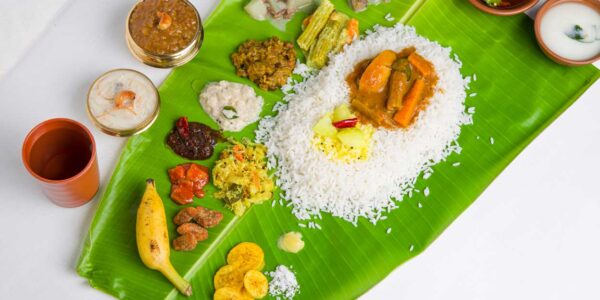Happy Vishu 2022: Enjoy the day with traditional Kerala sadya
Any auspicious occasion in Kerala, be it festivals like Onam and Vishu or a wedding, is incomplete without a sadya. It’s a feast of flavors showcasing the wide variety of Kerala’s stupendously rich vegetarian cuisine. To partake together, Kerala sadya epitomizes togetherness and community feeling.
What is sadya?
Sadya is a traditional feast of Kerala comprising dishes cooked to perfection to please the senses. The number of dishes served as part of a sadya spread can go up to 28. A traditional Kerala sadya consists of par boiled red rice, sambar, rasam, a few curries, savories, pickles, and desserts.
Traditionally served on a plantain leaf, Sadya commands some rules and etiquette. The tapering side of the leaf should point to the left of the person eating. Each item served has a designated place on the leaf and time to be introduced to the meal.
Traditional Kerala sadya items
Savories and pickles: Deep-fried banana chips, pappadams, puli in a sweet-and-sour and spicy curry made of ginger, tamarind, green chilies and jaggery, mango and lime pickles, a ripe small banana plantain.
Rice: Parboiled red rice is the traditional choice. Regular white rice is also popular now.
Parippu: A liquid curry made with small gram and ghee.
Sambar: A tangy and tasty vegetable stew made with arhar dal and an assortment of vegetables and spices.
Avial: A combination of vegetables cooked with coconut paste and green chilies tempered with curry leaves.
Thoran: A side dish made with beans, cabbage, or radish, mixed with grated coconut, red chilies, and turmeric powder.
Olan: A curry usually made of pumpkin and red grams cooked in coconut milk.
Kaalan: A dish made with banana, yogurt, and coconut.
Pachadi: A coconut and a yogurt-based dish made with vegetables or fruits, ginger, and curry leaves.
Kichadi: Crispy fried okra/ladyfinger in curd, seasoned with mustard, red chilies, and curry leaves.
Rasam: Rasam is a traditional preparation made of tomato, chili, pepper, cumin, and other spices as seasonings with tamarind juice as its base. Steamed lentils and vegetables are also added.
Sambharam/Morum vellum: Buttermilk seasoned with salt and chopped green chilies.
Payasams: Sweet puddings made of molasses, rice, lentils, milk, coconut milk, spices, and nuts. The items include paal (milk) payasam, palada pradhaman and kadalaparippu Pradhaman.
How a sadya is served
As mentioned above, those serving and partaking in Kerala sadya need to follow some rules and protocols. The leaf has to be positioned in a certain way, with the tapering side of it pointing to the left of the person eating. All the snack items and pickles are placed first on the left side of the leaf and a glass of water on the right.
Rice is then served, placed on the lower side of the leaf, followed by parippu. Then comes the sambar, poured over the rice. Avial, Thoran, Olan, and other side dishes follow one after the other. All main items are repeated as a rule for a second helping and can be re-repeated on demand.
Payasams are served next.
At the end of the meal, rasam is served, followed by sambharam.
Once the feast ends, the guest should fold the plantain leaf in half to signal he/she is done.
It’s Vishu on 15 April, Monday, and several restaurants across the country, and abroad, will be serving the Kerala sadya. If you want to enjoy this special spread, just head to your nearest Kerala food joint for lunch.


 For all latest news, follow The carefulu Google News channel.
For all latest news, follow The carefulu Google News channel.





